There are four seasons in a year: spring, summer, autumn and winter. Each season consists of 3 months, and there are 12 months in a year. Every month of the year has had its own name since ancient times. The names of the months of the year come from ancient times; in their names you can see what is happening at a given time of year, in a given month.
Let's take a closer look at each season.
Four sisters
Poems for children about the seasons
(author E. Karganova)
Nature has Four pages, Weather has Four sisters
Pages about every season
Spring in poems and pictures for children
Spring has come! Nature is awakening after winter, the sun is shining brightly, the snow is melting, birds from warmer climes will soon return to the forest, filling the forest with singing. The birds are about to sing, the flowers will bloom, and the forest will be dressed in green foliage.
In spring, snow begins to melt in the sun and turns into water; streams fill lakes with water; birds arrive; buds appear on trees from which small leaves grow; birds make nests, and insects appear in the forest and the entire flora and fauna awakens from hibernation.
Tell me what is shown in the picture in the spring?
Is it time to explore the seasons and months of the year with your children? Poems, riddles, games and songs will allow you to master the material easily and with interest. Tell your children about the seasons: what the weather is like and what clothes people wear, what games can be played outside, holidays and signs of the season.
A calendar in the form of a clock dial most clearly shows how the seasons change. You can cut out and attach the hand, like on a watch.
A child perceives material better when more senses are involved:
- Show the picture
- Say the name
- The child listens and repeats
- Make a craft that matches the season
Where to start learning
The basis and prevention for a child to study the months of the year is knowledge about the seasons themselves and the ability to navigate them.
You can start introducing the seasons from the year. To do this, there are a large number of illustrations that need to be shown to the child and told about what is depicted there.
You shouldn’t burden your child with long sentences and a large amount of material per year. 2-3 sentences that more vividly describe the time of year will be enough. You shouldn't show all the seasons at the same time. One day you show a picture of autumn several times a day for 5 minutes, the next day a picture of the next season.
Points worth paying attention to
- The child should be interested. If he doesn’t want to, he’s distracted, put the picture aside for later, he won’t remember anything anyway, but will only become more irritable.
- The baby should not have any physiological needs. He should be full, not want to go to the toilet and sleep.
The best way to remember all the signs of each season is observation. Lively and bright, where you can touch, listen, smell and take with you. After all, children of early preschool age learn tactilely, through touch and sensation.
Signs of the seasons
And now in more detail about the signs of each season that children should pay attention to. It is believed that learning must begin strictly in winter; it is brighter, more expressive and easier for children to remember.
Winter is the Snow Kingdom . It is necessary to give the child the opportunity to tactilely explore the snow. Take it in your hands, try to make a ball out of it or scatter it in a thin layer on the ground. Tell that the snow is cold and wet. Help the child build a semantic chain himself: winter-snow-cold and wet. At an older age, you can tell your child about winter holidays and winter entertainment.
Spring is the time when everything wakes up . Show the first leaves on the trees, buds. Listen with your child to how the stream “sings”. Tell them that birds are returning from warmer climes, introduce them using illustrations and poems, cartoons with animals waking up after hibernation.
Summer - here the child will know that this is a vacation with his parents or a fun time with his grandmother . But it should also be noted that only in the summer do a large number of fruits and vegetables that are useful and necessary for the body ripen. In summer, the nights become shorter and the days longer. You can pay attention to green trees and flowers. Watch the bugs and butterflies.
Autumn is the most beautiful time of the year , when the leaves that have changed color fall from the trees in some kind of dance. With your child, you can collect available materials: pine cones, chestnuts, leaves and create a craft together. During your walks, you can collect the most memorable leaves: red, green and yellow and create a herbarium. Tell us that in the fall it’s already getting colder, it’s getting dark earlier, and the birds are flying to warmer climes for the winter.
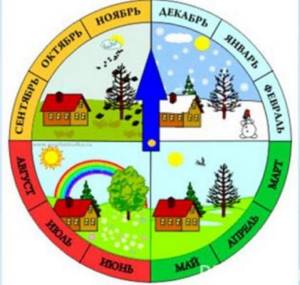
At the age of 2-3 years, a child should have a good knowledge of the seasons, know their signs and navigate the sequence. By the age of 5, a child can be introduced to the months and taught to pronounce them correctly.
MONTHS OF THE YEAR
JANUARY was walking through the snowdrifts, the king of all winter frosts! FEBRUARY caught up with him - he lost his shawl from the blizzard.
MARCH came running to replace him and the ringing rang: “Spring, let’s start!” APRIL sailed along the streams, he carried drops in his pocket.
MAY rustled the leaves: “Take off your warm jacket!” The dandelion carried JUNE. Do you want a miracle? Just blow!
And in JULY, and in July we had a rest at the sea! AUGUST buzzed with bees and sat like a mushroom in the forest.
In golden SEPTEMBER we forgot about the heat! The wind blew OCTOBER: let's pick up yellow leaves!
NOVEMBER froze us, throwing the first snow on the ground. DECEMBER is coming to us, ending a long year!
Game “Dress the kitten according to the season”:
I drew this cute kitten with a set of clothes for all 4 seasons. It is better to print the cat on thick paper, and the clothes on regular paper, and then cut it out. In the hats, make slits for the ears along the line.
Let your child choose suitable clothes for summer, winter, spring or autumn.
You can also come up with a seasonal craft with your child. I offer a couple of our ideas:
click on the picture to go.
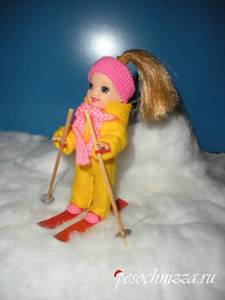
Some more ideas for crafts:
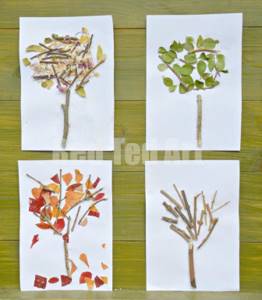
The next tutorial is the game “Seasons”. Print out the pictures and cut them into cards. There is no need to cut the last picture with inscriptions. You need to put cards on it according to the season.
Riddles about the seasons
RIDDLES ABOUT WINTER
* * * I dusted the paths and decorated the windows. She gave joy to people And took her for a ride on a sled (Winter) * * * I have a lot of things to do - I cover the whole earth with a white blanket, I clear the rivers into ice, I whiten the fields, the houses They call me... (Winter) * * * I covered the earth with a blanket, I bound the rivers with strong ice and painted our windows with sparkling white silver. (Winter) * * * Snow on the fields, Ice on the rivers, Blizzard is walking. When does this happen? (Winter)
RIDDLES ABOUT SPRING
* * * The snow is melting, the streams are ringing, The streams are getting stronger. And the rooks are already flying to us from distant lands. (Spring) * * * I open the buds, I dress the trees in green leaves, I water the crops, I am full of movement, My name is... (Spring) * * * She comes with affection and with her fairy tale. He waves his magic wand and the snowdrop blooms in the forest. (Spring) * * * The snowball is melting, the meadow has come to life, the day is coming, when does this happen? (In spring) * * * She came and smiled. The snowstorms subsided. The drop bell began to ring. The river has awakened, the ice has melted, the gardens have been dressed in snow-white clothes. (Spring)
RIDDLES ABOUT SUMMER * * * The forest is full of songs and screams, Strawberries are splashing with juice, Children are splashing in the river, Bees are dancing on a flower... What is this time called? It’s not difficult to guess... (Summer) * * * The sun is baking, the linden tree is blooming, the rye is ripening. When does this happen? (In summer) * * * I am woven from the heat, I carry warmth with me, I warm the rivers, “Swim!” - I invite you. And you all love me for this. I... (Summer) * * * It comes to visit us after spring, and brings with it a lot of worries. Hot, long Gives days, So that the spikelets ripen quickly in the fields (Summer)
RIDDLES ABOUT AUTUMN
* * * So the days have become shorter, And the nights have become longer, The birds are stretching to the south, The forest and meadow have turned yellow. (In autumn) * * * The fields are empty, the ground is getting wet, the rain is pouring down. When does this happen? (Autumn)
* * * I bring the harvests, I sow the fields again, I send the birds to the south, I strip the trees, But I don’t touch the pines and fir trees. I... (Autumn) * * * Walked through the meadows, through the forests, through the fields, she prepared supplies for us, hid them in cellars, in bins, said: “Winter will come for me.” (Autumn)
Your baby is growing and it’s time to tell him that after autumn comes winter, and after spring always comes summer. Parents are wondering what the most effective and simple teaching methods exist, how to make the seasons clear to children?
The concept of "Seasons"
Read the poems (or listen).
Tell me when does this happen? For each poem, draw a tree that you can see at this time of year. Say the opposite: summer - ..; spring - ..; Cold - ..; wet - ..; bloom - ..; fly away - ... The storm covers the sky with darkness, spinning whirlwinds of snow: Then she will howl like an animal, Then she will cry like a child. A. Pushkin
The field is sunny and quiet. The hot day dries the earth. Buckwheat thought about it. Barley hung his head. G. Ladonshchikov
From the midday rays a stream ran down the mountain, and a small snowdrop grew in a thawed patch. G. Ladonshchikov
Boring picture! The clouds are endless, the rain keeps pouring down. Puddles by the porch. A. Pleshcheev
There is a tree in the royal garden. On one side the flowers bloom, on the other the leaves fall, on the third the fruits ripen, on the fourth the branches are pruned. What kind of tree is this? - This is the year.
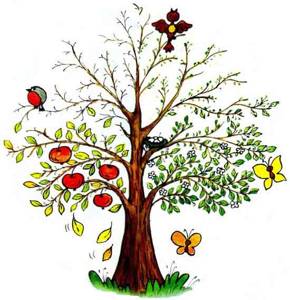
Find the extra word: winter, cold, frosty, calm, snowy, blizzard.
Come up with similar words: hot,.. Let's play together: If you are picking mushrooms, this is..., if the buds are swelling, this is..., if you are walking in felt boots, this is..., if you are wearing a warm jacket, this is... or... Determine which the seasons are shown in the pictures. What happens to a tree in winter, spring, summer and autumn?
What season do these objects remind you of?
Tell your child that a year consists of 12 months.
Let's divide the months by seasons:
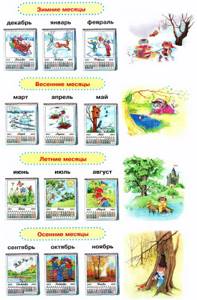
After this, learn the names of the months with your child. Here you need to learn with your child how many days there are in which month and how you can determine this.
Name the winter, spring, summer and autumn months. Tell me what is shown in the pictures. Look at the pictures and tell us what is happening in nature at this time.
Find the extra item in each group. Explain your choice.
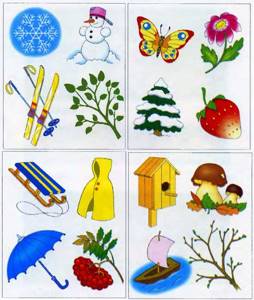
Look at the pictures and tell me when this happens? Name the time of year.
Guess riddles about time
| These birds fly in a line, And never come back. There are seven birds in every flock, you all know them! (Days of the week.) |
| Twelve brothers wander after each other, but do not overtake each other. (Months.) |
| The bridge stretches for seven miles, and at the end of the bridge is the Golden Mile. (A week.) |
| Every year they come to visit us: One is gray-haired, Another is young, The third is jumping, And the fourth is crying. (Seasons.) |
How to use your hands to determine the number of days in any month? Clench your hands into fists and turn them as shown in the picture.
| JANUARY – 31 | JULY – 31 |
| FEBRUARY – 28 (29) | AUGUST – 31 |
| MARCH – 31 | SEPTEMBER – 30 |
| APRIL – 30 | OCTOBER -31 |
| MAY – 31 | NOVEMBER – 30 |
| JUNE – 30 | DECEMBER – 31 |
Listen to the poem.
Tell me, how many days are there in February in a leap year? Thirty days are always in September, April, June and November.
One day more in other months, Only February does not want to catch up. It has only twenty-eight days, but in a leap year it is a day longer. Determination of the sign of the year according to the Chinese horoscope. I WAS BORN:
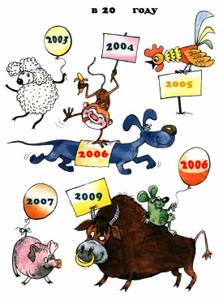
Determine what zodiac sign you were born under: I WAS BORN:
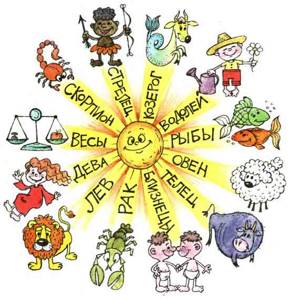
| CAPRICORN DECEMBER 22 – JANUARY 20 | CANCER JUNE 22 – JULY 22 |
| AQUARIUS JANUARY 21 – FEBRUARY 18 | LEO JULY 23 – AUGUST 23 |
| PISCES FEBRUARY 19 – MARCH 20 | VIRGO AUGUST 23 – SEPTEMBER 23 |
| ARIES MARCH 21 – APRIL 20 | LIBRA SEPTEMBER 24 – OCTOBER 23 |
| TAURUS APRIL 21 – MAY 21 | SCORPIO OCTOBER 24 – NOVEMBER 22 |
| GEMINI MAY 22 – JUNE 21 | SAGITTARIUS NOVEMBER 23 – DECEMBER 21 |
Remember the names of the months in English
for Russian speakers it is usually not a big deal, since the English months are consonant with the Russian equivalents.
But still, sometimes English language learners doubt how to correctly pronounce January or August in English, what preposition to put in front of the months, and how to correctly write the English months in abbreviation.
We are nearer to Spring, than we were in September, I heard a bird sing in the dark of December.
We are closer to spring now than we were in September. I heard a bird singing in cold December.
~ Oliver Hereford “I Heard a Bird Sing”
Set expressions with months in English
In English, stable phrases that have a figurative meaning are very common.
Many English idioms contain names of months
. We will introduce you to the most interesting of them.
| Idiom in English | Russian translation | Meaning |
| slow as molasses in January | slow as molasses in January | So slow |
| mad as a March hare | mad as a March hare | crazy |
| Maybees don't fly in June! | May bees do not fly in June. | Stop changing your mind! |
| a cold day in July | cold day in July | not soon and unlikely |
| February fair-maid | February filling the ditches | rainy period |
| February fair-maid | February sardine | snowdrop |
| April fish | April fish | April Fool's joke |
| April weather | April weather | now rain, now sun / now laughter. then tears |
| May and December/January | May and December (January) | big difference/unequal marriage |
Knowing English idioms for months will help you improve your speech and feel a little like a native speaker.
Baby calendar
The seasons are easy to distinguish from each other. Each season brings with it an important, interesting event. For example, birthdays, family dates and holidays, New Year, so beloved by children. Start making a personal calendar with your child:
- In winter, Santa Claus comes to the baby with gifts, dad brings a Christmas tree, and the baby dresses it up.
- In the summer, the whole family goes to the sea: your parents are on vacation, mom and dad are both at home, and you have fun together in nature.
- In autumn it rains and you can run through puddles in boots, while older children go to school with backpacks.
- In spring, the snow melts and the first flowers bloom, the leaves on the trees become more and more green right before our eyes.
With your help, your child notices and learns the names of the seasons. Months are more difficult. Not only is it so difficult to remember their names, you also need to learn the order of how they run after each other, like a round dance.
Game techniques for better memorization of the seasons
Make 12 cards that represent each of the 12 months. These can be pictures of nature, people, fragments from fairy tales and cartoons. Invite your child to choose the card he likes, name the season depicted on it and prove his point.
For example: “It’s February because the picture shows icicles falling from the roof. It's always cold here in February. I remember seeing lots and lots of icicles this winter.”
When your child talks about each month in turn, ask him to put the cards in the correct order.
It is important!
If your child fails to indicate the order in which the cards should be laid out, ask him to choose three cards from each season and put them in 4 different piles.
After this, think with your child what time of year each stack of cards belongs to, arrange them in the correct sequence: winter, spring, autumn, winter. At the very end, help your child choose the correct order for each of the 3 months in the category.
Another effective method for remembering the seasons is to study poems.
Together with your child, choose a few simple quatrains about different seasons and ask him to learn them by heart. This will also help you understand what a particular month is by memorizing visual images. Good examples of poems about the months of the year can be the works of such authors as: Fet, Tyutchev, Pushkin, Yesenin and others.
These educational materials will help your child quickly learn and remember the names of the seasons and months. Download and print the calendar picture; you will need to hang it in a visible place so that the child often sees the calendar with his eyes during the day. He will involuntarily scroll through his memory the names of the seasons, winter, spring, summer and autumn months.
Naturally, before this it is necessary to familiarize the child with these seasons. Start your story with winter. Be sure to tell the signs of what is happening in nature at this time of year, what the weather is like, so that the child can feel and vividly imagine the full picture of the season.
in winter
the day is short. The sun is low and warms weakly. Snow falls. Cold. People wear winter clothes. In winter we celebrate everyone's favorite holiday - New Year.
in spring
the day is getting longer. The sun is warming better. It is getting warmer. Snow is melting. Streams are flowing. Leaves appear on the trees. Grass begins to grow. Flowers are blooming. Migratory birds arrive. People wear demi-season clothes. The most famous spring holidays are March 8 and May Day.
In summer
the sun is high, shining brightly, warming well. The weather is hot. Flowers bloom and berries appear. People wear summer clothes. You can swim in natural reservoirs and sunbathe.
in autumn
the day is getting shorter. The sun is lower. It's getting colder. The harvest of vegetables and fruits is ripe. Leaves are falling from the trees. Migratory birds fly south. It rains often. People wear warm clothes. The most famous autumn holiday is the Day of Knowledge.
And winter comes again...
Don’t forget to discuss the very concept of “seasons” and what a year is. Children often confuse “season”, “time of day”, “week”, “month” and simply “time”, immediately distinguish between these concepts. Riddles will help with this:
There is a tree in the royal garden. On one side the flowers bloom, on the other the leaves fall, on the third the fruits ripen, on the fourth the branches are pruned. What kind of tree is this? (year)
These birds fly in a line, And never come back. There are seven birds in every flock, you all know them! (Days of the week.)
Twelve brothers wander after each other, but do not overtake each other. (Months.)
The bridge stretches for seven miles, and at the end of the bridge is the Golden Mile. (A week.)
Every year they come to visit us: One is gray-haired, Another is young, The third is jumping, And the fourth is crying. (Seasons.)
Invite your child to come up with his own story about the seasons.
Don't forget to tell your child that a year consists of 12 months.
, and each season has 3 months.
Methods for remembering months and seasons of the year
When should a baby start getting acquainted with the outside world? It is best to start a detailed acquaintance with the months when the child starts talking. Now each of your walks becomes not only entertainment, but also an activity. But how to teach your child the months of the year and the names of the seasons is not difficult; start implementing the techniques from this article right now:
- Play games.
- Create drawings.
- Learn and compose poems, riddles, fairy tales, stories, cartoons.
- Use associations and memorable dates.
- Pay attention to the sensations.
- Explain why seasonal clothing is worn.
- Link your baby's favorite holidays to months.
- Contemplate, finding with your baby all the changes that occur.
Detailed description of methods. The child is 2 years old
Walks. Active, linguistic observation of nature can be taught from the age of 2. Every new day, focus your child’s attention on the weather, what season and month it is. Describe in words everything you find and feel today. Become a walking and talking encyclopedia for your child.
What is it for. The information will be stored subconsciously, that is, your baby will instinctively know the names of the months and what is connected with them, without specifically learning them. This long-term memory will help him later when you move on to educational games.
The child turned 3 years old. Educational games
There are special nature calendars, “Seasons” lotto and their digital analogues for children. Take 4 identical parts of a sheet, stick a picture on each, which will make it easier for your child to explain the difference between winter and summer. Label the pictures and place each card on an envelope to hold pictures of seasonal clothing, holiday cards, and other images. At five years old, you will replace these pictures with pictures with the names of the months. The top flap of the envelope should be cut off so that the cards are visible from it, and it is easy for the baby to get them with his fingers.
First you need to let your child remember the names of the seasons and what is connected with them. Discuss with him what you can do when there is snow, the sun is shining hot, and it is raining. At the same time, it is better to start learning the alphabet, and you can start mastering the months at 5 years old. Be patient, as it is quite difficult to get the names of the months and their sequence into your head. But, in anticipation of his fifth birthday, your child, having mastered the alphabet, will be able to more easily perceive information and structure it.
We learn the seasons and months
Friends, if you don’t yet know how the seasons and months sound in French, then it’s time to find out and remember it well, because these words are very often found in French speech:
Les saisons de l'année – seasons:
- L'hiver – winter
- Le printemps – spring
- L'été – summer
- L'automne - autumn
Les mois de l'année - months of the year
- Janvier – January
- Février – February
- Mars – March
- Avril – April
- Mai – May
- Juin – June
- Juillet – July
- Août – August
- Septembre – September
- Octobre – October
- November - November
- December - December
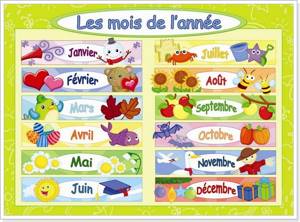
Some necessary expressions:
- Janvier est le primer mois de l'année. – January is the first month of the year.
- Quand est ton anniversaire? Mon anniversaire est le vingt-quatre avril. - When's your birthday? My birthday is the twenty-fourth of April.
- Décembre est le dernier mois de l'année. – December is the last month of the year.
- Après fevrier vient le mois de mars. – After February comes the month of March.
- Le huit mars est la fête des femmes. – The eighth of March is a women’s holiday.
- On célèbre les Pâques en printemps. – Easter is celebrated in the spring.
- L'automne est la saison de récolte. – Autumn is harvest time.
Poems, riddles, fairy tales, cartoons, children's films
In the period from 3 to 5, the baby also receives information about the seasons and months from literature and television. There are many riddles and quatrains on this topic that can be easily learned by heart.
Winter.
Smoke is coming from the chimney. Glass is painted. Let's go sledding. We are not cold - we are warm.
Summer.
Summer is upon us again! It became hot and light. Barefoot feet run straight along the paths.
Spring.
A week of March will fly by, April will ring like drops, May will come to us in flowers after it, Our city will be flooded with sunshine.
Autumn.
If the leaves in the forest have turned yellow, If the blue birds have flown into the sky, If the cloud is gloomy or the rain is pouring, Everything outside the window is called autumn.
Good films were created back in Soviet times: “Twelve Months”, “Morozko”, “Three Nuts for Cinderella”, the film about spring “Snow Maiden”, which well shows the change of seasons and the melting of snow. Watch them with your child and talk about these moments. Even if your child watched a movie or cartoon himself, discuss with him what he liked most and what upset him, and what he would do. Pay special attention to the details of the seasons.
How to teach children the names of months and seasons
Your baby is growing and it’s time to tell him that after autumn comes winter, and after spring always comes summer. Parents are wondering what the most effective and simple teaching methods exist, how to make the seasons clear to children?
Baby calendar
The seasons are easy to distinguish from each other. Each season brings with it an important, interesting event. For example, birthdays, family dates and holidays, New Year, so beloved by children. Start making a personal calendar with your child:
- In winter, Santa Claus comes to the baby with gifts, dad brings a Christmas tree, and the baby dresses it up.
- In the summer, the whole family goes to the sea: your parents are on vacation, mom and dad are both at home, and you have fun together in nature.
- In autumn it rains and you can run through puddles in boots, while older children go to school with backpacks.
- In spring, the snow melts and the first flowers bloom, the leaves on the trees become more and more green right before our eyes.
With your help, your child notices and learns the names of the seasons. Months are more difficult. Not only is it so difficult to remember their names, you also need to learn the order of how they run after each other, like a round dance.
Methods for remembering months and seasons of the year
When should a baby start getting acquainted with the outside world? It is best to start a detailed acquaintance with the months when the child starts talking. Now each of your walks becomes not only entertainment, but also an activity. But how to teach your child the months of the year and the names of the seasons is not difficult; start implementing the techniques from this article right now:
- Play games.
- Create drawings.
- Learn and compose poems, riddles, fairy tales, stories, cartoons.
- Use associations and memorable dates.
- Pay attention to the sensations.
- Explain why seasonal clothing is worn.
- Link your baby's favorite holidays to months.
- Contemplate nature on walks, observing with your baby all the changes that occur.
Detailed description of methods. The child is 2 years old
Walks. Active, linguistic observation of nature can be taught from the age of 2. Every new day, focus your child’s attention on the weather, what season and month it is. Describe in words everything you find and feel today. Become a walking and talking encyclopedia for your child.
What is it for. The information will be stored subconsciously, that is, your baby will instinctively know the names of the months and what is connected with them, without specifically learning them. This long-term memory will help him later when you move on to educational games.
The child turned 3 years old. Educational games
There are special nature calendars, “Seasons” lotto and their digital analogues for children. Take 4 identical parts of a sheet, stick a picture on each, which will make it easier for your child to explain the difference between winter and summer.
Label the pictures and place each card on an envelope to hold pictures of seasonal clothing, holiday cards, and other images. At five years old, you will replace these pictures with pictures with the names of the months.
The top flap of the envelope should be cut off so that the cards are visible from it, and it is easy for the baby to get them with his fingers.
First you need to let your child remember the names of the seasons and what is connected with them. Discuss with him what you can do when there is snow, the sun is shining hot, and it is raining.
At the same time, it is better to start learning the alphabet, and you can start mastering the months at 5 years old. Be patient, as it is quite difficult to get the names of the months and their sequence into your head.
But, in anticipation of his fifth birthday, your child, having mastered the alphabet, will be able to more easily perceive information and structure it.
Poems, riddles, fairy tales, cartoons, children's films
In the period from 3 to 5, the baby also receives information about the seasons and months from literature and television. There are many riddles and quatrains on this topic that can be easily learned by heart.
Winter.
Smoke is coming from the chimney. Glass is painted. Let's go sledding.
We are not cold - we are warm.
Summer.
Summer is upon us again! It became hot and light. Straight along the paths
Feet run barefoot.
Spring.
A week of March will fly by, April will ring like drops, May will come to us in flowers after it,
The sun will flood our city.
Autumn.
If the leaves in the forest have turned yellow, If the blue birds have flown into the blue sky, If the cloud is gloomy or the rain is pouring,
Everything outside the window is called autumn.
Good films were created back in Soviet times: “Twelve Months”, “Morozko”, “Three Nuts for Cinderella”, the film about spring “Snow Maiden”, which well shows the change of seasons and the melting of snow.
Watch them with your child and talk about these moments. Even if your child watched a movie or cartoon himself, discuss with him what he liked most and what upset him, and what he would do.
Pay special attention to the details of the seasons.
Child 5-6 years old
By the age of five, your child, as a rule, has already mastered the alphabet, clearly knows the difference between winter and spring, and even expresses his preferences for which season he likes most. Now is the time to explain to him the order in which the months go.
Association games
It's time to take 12 cards out of our envelopes and study them in detail. Ask your child to put the months in order and tell him what he remembers about them, when Christmas or grandma’s name day will be, what clothes people wear in January, when you go on vacation.
Making unusual watches
- Divide the thick cardboard circle into 4 parts. These will be sectors with images of the seasons. Divide each sector into 3 parts and write the names of the months.
- Attach the hands to your clock.
- Place the arrows in the right place.
- Every first number, change the direction of the arrow. Of course, it’s better to let the baby do it himself.
Now, seeing all the months at once every day, the child will intuitively remember their location. Pay his attention to the “Clock of the Seasons”.
“What season of the year is it now? Is it autumn now, September?”
Don't forget about spiritual intimacy
Psychologists say that playing together, communicating, walking, doing crafts, and helping preschoolers in the kitchen and housework form warm memories that will save them in adulthood. While children are small, we don’t just teach them, we lay a strong foundation, deep roots that will not allow them to fall in difficult moments of life.
Don't worry if your child is slow to learn the names of the months and seasons. Arriving at school, he will easily consolidate this skill in the first year. From the age of six, you can start writing the date and month in your copybooks every day.
Also, don't limit yourself to our recommendations.
Each child is individual and if you decide that at the age of three it will be useful for him to see a clock with seasons, then try it, only you yourself will find the right key for your little one.
Child 5-6 years old
By the age of five, your child, as a rule, has already mastered the alphabet, clearly knows the difference between winter and spring, and even expresses his preferences for which season he likes most. Now is the time to explain to him the order in which the months go.
Association games
It's time to take 12 cards out of our envelopes and study them in detail. Ask your child to put the months in order and tell him what he remembers about them, when Christmas or grandma’s name day will be, what clothes people wear in January, when you go on vacation.
Making unusual watches
- Divide the thick cardboard circle into 4 parts. These will be sectors with images of the seasons. Divide each sector into 3 parts and write the names of the months.
- Attach the hands to your clock.
- Place the arrows in the right place.
- Every first number, change the direction of the arrow. Of course, it’s better to let the baby do it himself.
Now, seeing all the months at once every day, the child will intuitively remember their location. Pay his attention to the “Clock of the Seasons”. “What season of the year is it now? Is it autumn now, September?”
Don't forget about spiritual intimacy
Psychologists say that playing together, communicating, walking, doing crafts, and helping preschoolers in the kitchen and housework form warm memories that will save them in adulthood. While children are small, we don’t just teach them, we lay a strong foundation, deep roots that will not allow them to fall in difficult moments of life.
Don't worry if your child is slow to learn the names of the months and seasons. Arriving at school, he will easily consolidate this skill in the first year. From the age of six, you can start writing the date and month in your copybooks every day. Also, don't limit yourself to our recommendations. Each child is individual and if you decide that at the age of three it will be useful for him to see a clock with seasons, then try it, only you yourself will find the right key for your little one.
How to teach your child the months of the year
Look for Rastishka in stores with characters from the animated series “Paw Patrol!” Unique packaging design and a collection of 16 magnets in 6x45 g curds. Delight your children with a complete collection featuring their favorite characters! Yoghurts and curds “Rastishka” are enriched with Ca and D3.
100 g of yogurt or cottage cheese provides 20-27% of the daily calcium requirement of preschool and school-age children.
How to explain to a child what the months of the year are and in what order they come? What are the seasons and which months belong to which time.
sva-mama.ru
Seasons and months are abstract concepts. It is not so easy to explain to a baby something that he cannot touch. Why, for example, is it hot in summer and cold in winter? What is February and why is March called that?
How to dress at this or that time of the year, how one season differs from the second. In order for your baby to better understand and quickly remember the months of the year, you will have to turn on your imagination to the fullest.
We will tell you how to teach the months of the year while playing.
Learning months: at what age to start
From about 4 years old, you can begin to teach your child the seasons.
He has already observed the change of seasons several times in his life and will be able to find common signs characteristic of each season. He already imagines what rain and snow are, he has seen clear and cloudy skies, he knows that sometimes trees have leaves, and at other times without them, etc. The child consciously perceives what “cold” and “hot” mean.
You need to teach your child to dress according to the season. Our master class from Dino will help with this.
It is not enough to simply name the seasons; you need to come up with a description for each of them, highlight the characteristic changes that occur at this time in nature and people’s lives.
By the age of 4, 5 - 5, you can explain what months are and learn their names. Tell which months belong to which time of the year.
Methods for teaching a child the seasons
It is best to start learning with colorful pictures that depict the seasons. New information is learned better in a playful way. Can:
— Make a weather calendar with your child. — Stage costume skits. — Watch educational cartoons on this topic. — Make riddles. — Play games.
— Read thematic poems and fairy tales.
We recommend:
- Seasons. A fairy tale for children.
— Draw the seasons using various techniques and make all kinds of crafts.
We recommend:
Do you want your child to quickly remember the seasons and months? Pay attention to the world around you more often. While walking, it would be useful to look at the sky, describe its color and the state of the clouds.
Pay attention to the leaves of the trees, to the precipitation, to the behavior of animals and birds, to what people do in one month or another of the year, to seasonal holidays (New Year in winter, March 8 in spring, etc.).
You can make educational games and all kinds of cards with your own hands that will help your child remember the seasons.
www.razumniki.ru
Ask your child to carefully look at the pictures and answer the question which seasons correspond to the objects depicted.
shop.amelica.com
The “Seasons” lotto will become your indispensable assistant in your child’s development and teaching him about the seasons.
igraem-s-mamoi.ru
Make 4 pockets corresponding to the seasons. Choose several thematic pictures for each season. Shuffle the cards and invite your child to put the pictures in the pockets. If you periodically change the pictures, then the baby will not get tired of playing this game with his mother for a very long time.
You can make a video presentation on your computer from colorful pictures or your own photographs, which will reflect all the seasons.
www.razumniki.ru
Using the example of a tree, you can very clearly show what happens in winter, spring, summer and autumn. You can select one object near your home and observe it, noting what changes. For example, a flower bed, birch tree, etc.
Methods of teaching a child months
If the child has already memorized the seasons and learned them well, start studying the months.
Twelve brothers wander after each other, but do not overtake each other. (months)
Each season lasts three months. To make it easier for your child to remember them, draw a table and, together with your child, come up with symbols for each month.
Read to your child S. Marshak’s poem “All Year Round” or other poems that highlight the features of each month. You can pick up coloring books on this topic.
Tell us that a year consists of 12 months. Tell me in what order they come. Introduce your child to the fairy tale “12 months”, so he will quickly understand why the months follow each other strictly and this order is never broken.
Show the calendar, tell how many days there are in each month. A calendar with a window that the child can move independently is very convenient.
Make cards with images specific to each month. For example, it is February because snow, a blizzard and a man wrapped in a warm fur coat are depicted. It's August because the storks are flying, the combine is harvesting the fields, there are hay bales, etc.
Invite your child to choose any of the 12 cards and explain to himself which month is depicted and on what grounds he made this conclusion. When your child talks about each month, ask him to put the cards in the correct order.
If it’s difficult at first, let them arrange them in 4 piles according to the seasons.
The child’s own associations will help him remember in what order the months follow each other, and he will quickly learn to navigate space-time relationships. If you are going on a trip, be sure to discuss this with your child based on the date. Consider how many months are left before your planned vacation.
How to remember the number of days in each month
An old, time-tested way to remember how many days are in which month is with your own knuckles. Clench your fists and start counting.
Learn this poem with your child:
There are always 30 days in September, in April, June and November. A day more in other months, Only February does not want to catch up. It has only 28 days,
But in a leap year it is a day longer.
Source: https://rastishka.by/articles/kak-nauchit-rebenka-mesyacam-goda/








